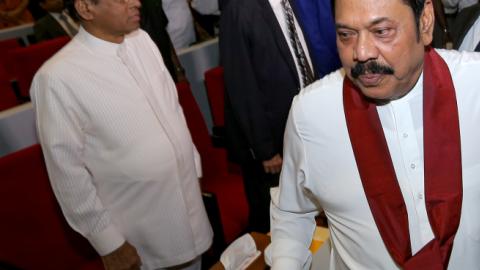Sri Lankan Prime Minister Ranil Wickremesinghe has acknowledged that Sri Lanka is negotiating a bailout with the International Monetary Fund (IMF) “as a bankrupt country.”
Sri Lanka is not the only South Asian country facing an economic crisis that borrowed heavily from China for infrastructure projects, which the Chinese have described as part of its Belt and Road Initiative (BRI). Nepal, Maldives and Pakistan are also going through economic convulsions.
Ironically, China, which over the years was quick to offer high-interest loans for infrastructure projects in Sri Lanka, has been quiet during its current crisis. President Gotabaya Rajapaksa – who along with his brother, former President and Prime Minister Mahinda Rajapaksa, was responsible for Sri Lanka’s heavy borrowing from China – recently lamented that South Asian countries in financial trouble are not getting the same attention from Beijing as before.
Rajapaksa was reported as saying that Sri Lanka was unable to tap a $1.5 billion credit line from Beijing and his request to Chinese President Xi Jinping for a $1 billion loan to buy essential goods had gone unanswered. Sri Lanka’s budget deficit is now 13 percent of its GDP and there is less than $2 billion in foreign exchange reserves.
For years, China has planned to encircle India and force the United States out of South Asia by bribing elites and offering their countries massive loans for grandiose infrastructure projects. China now faces the prospect of diminished influence in a region where a few years ago its footprint seemed to be growing.
Chinese officials are trying to ride out the political fallout of the economic debacle by stepping up anti-U.S. rhetoric. Sri Lanka’s crisis, and that of other countries around it, demonstrates that China’s lending policies are based less on economic viability and more on giving China strategic advantage. Sri Lanka – once the model for countries like Singapore – has defaulted on multi-million-dollar debt interest payments and faces fuel and food shortages. The Sri Lankan rupee is currently the worst performing currency globally.
The Chinese are, meanwhile, sitting in the Indian Ocean port of Hambantota, which they took over in 2017 on lease as part of repayment of their loan to Sri Lanka. With little trade flowing through Hambantota, China’s interest in the port can only be strategic, with future military use as a possibility.
This is a tragic fall for a country that has ranked the highest in its region in human development indices and, until recently, had a higher GDP per capita ($3,850) than India, Pakistan or Bangladesh. Even in 2019, Sri Lanka had $7.5 billion in foreign exchange reserves. But expensive and unproductive infrastructure projects have become a major factor in the country’s economic decline.
Other countries in South Asia have also been saddled with Chinese-funded white elephants — projects whose cost, particularly maintenance, is disproportionately higher than their economic return. Chinese lending caused a severe economic crisis two years ago in the Maldives. Nepal, which also borrowed from China for infrastructure projects, faces balance of payments challenges.
Pakistan, China’s closest friend in South Asia, is negotiating with the IMF to avert defaulting on its financial obligations. The China Pakistan Economic Corridor (CPEC), a set of infrastructure projects linking the two countries, was once trumpeted as a game changer for Pakistan. It now seems nothing more than a Chinese effort to find a foothold on the coast of the Arabian Sea and close to the oil-producing Gulf states.
China is Pakistan’s single largest creditor. Pakistan’s external debt stands at $131 billion, of which $ 41 billion is owed to multilateral creditors, and almost $19 billion to China. Instead of bolstering Pakistan’s economy, the heavy borrowing from China and economic mismanagement have resulted in double digit inflation and erosion in the value of the Pakistani rupee. During the latest crisis, China has offered nuclear-armed Pakistan further loans, but that would only further draw the country into China’s “debt trap.”
The economic problems in both Sri Lanka and Pakistan are partly structural. Elites in both countries pay little in taxes, while supporting large military budgets. Endless war against the Tamil minority in Sri Lanka, and against India and Afghanistan in Pakistan’s case, is hardly conducive to investment.
When to declare for 2024? Trump’s complicated presidential calculus
The COVID-19 pandemic and higher oil prices have also taken a toll on all South Asian economies. But none of these factors should minimize the impact of some governments’ decision to tie their fortunes to China’s infrastructure schemes. Unlike western and multilateral donors, who are sometimes willing to convert loans into grants, China reluctantly agrees to defer, but never cancel a due payment.
Once Sri Lanka and Pakistan get through their current challenges, most likely with the IMF’s support, they would do well to scale back their reliance on China as a partner. Borrowing from China has proved a poor substitute for structural economic reforms recommended by western governments and institutions, which South Asian elites often tend to resent.
Read in The Hill




















